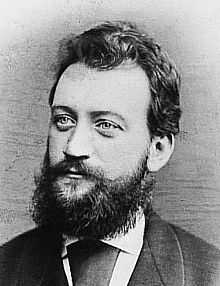Gräfin Dubarry
| Operas by Carl Millöcker |
|---|
 |
|
Performance history
The operetta had its premiere on 31 October 1879 at the Theater an der Wien, Vienna.
Die Dubarry
A radically new version of the work, in nine scenes under the title Die Dubarry, was prepared by Theo Mackeben with music from the original Gräfin Dubarry as well as other works, and a new text was written by Paul Knepler, Ignaz Michael Welleminsky and E. M. Cremer. This was first given at the Admiralspalast in Berlin on 14 August 1931. According to Andrew Lamb, this introduced "alien structures and orchestration" compared with the original. [1]
Roles
| Role | Voice type | Premiere cast, 31 October 1879 (Conductor: Carl Millöcker[2]) |
Die Dubarry cast, 14 August 1931 (Conductor: [3]) |
|---|---|---|---|
| Marie Jeanne Bécu, a milliner, later Comtesse Dubarry | soprano | Gitta Alpar | |
| René Lavallery, a painter | tenor | Egon Brosig | |
| Margot, a milliner | soprano | Edith Schollwer | |
| Marquis de Brissac, her friend | tenor | ||
| Comte Dubarry | baritone | Schnell | |
| King Louis XV | baritone | ||
| Duc de Choiseul, Chief Minister | spoken | ||
| Prince Soubise | spoken | ||
| Duc de Lazun | spoken | ||
| Radix de St. Foix | spoken | ||
| Baron Chamard | spoken | ||
| Lebell | spoken | ||
| Marschallin von Luxembourg | spoken | ||
| Lucille | spoken | ||
| Pierre | spoken | ||
| Madame Labille | spoken | ||
| Marianne Verrières | spoken | ||
| Claude Verrières | spoken | ||
| Abbé | spoken | ||
| Neighbour | spoken | ||
| Attendants, companions, servants, milliners, people of Paris (chorus) | |||
Synopsis
The story is set in Paris and Versailles in 1764.
Film version
A film version was made in Germany in 1951 by Georg Wildhagen, with Sari Barabas, Mathieu Ahlersmeyer, Willy Fritsch, Albert Lieven and Walter Müller.
References
- ↑ Lamb, Andrew (1992), 'Millöcker, Carl' in The New Grove Dictionary of Opera, ed. Stanley Sadie (London) ISBN 0-333-73432-7
- ↑ Amadeus Almanac, accessed 1 July 2008
- ↑ Amadeus Almanac, accessed 1 July 2008
Some of the information in this article is taken from the German Wikipedia article.